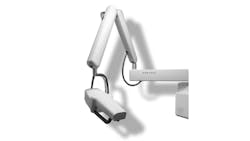Pearls for Your Practice: Portray 3D Tomosynthesis
I carry an iPad with me almost everywhere I go. It wasn’t always like that, though. When the iPad first came out, people wondered why they would need it. It was a weird thing between a laptop and a phone. Of course, we now know how useful tablets are, but at the time, many people thought they were silly.
Recently, I was introduced to a new radiographic technology called 3D tomosynthesis. It’s not quite a cone beam CT. It’s not quite a periapical radiograph (PA). Like the iPad, it’s somewhere in the middle. I think we will find in dentistry that Portray is just as indispensable as the iPad has become to our everyday lives!
More Pearls:
Portray is a radiographic device that allows us to capture 3D tomosynthesis images of teeth or implants. It works by capturing multiple images in sequence to create a 3D volume image of the area. This will help in diagnosing things like caries, cracked teeth, and periapical radiolucencies. Using Portray’s software, we can scroll through an image, revealing multiple different planes of view. In my practice, I have used it to detect fractures in teeth as well as diagnose decay that I didn’t see on a traditional bitewing or periapical radiograph.
This is not a cone beam CT system, and it doesn’t expose the patient to nearly that much radiation. This is a focused series of traditional two-dimensional radiographs that are taken with specific angles and exposure settings, and then compiled in special software. This allows us to get different views of teeth that traditional two-dimensional radiographs don’t show.
The advantage of this over a CBCT system is the diminished radiation and focused nature of the images. No need to be worried about incidental pathologic findings when we are using 3D tomosynthesis, and no need to have a radiologist read the CBCT scan to make sure we aren’t missing something crazy—just a volumetric image of the teeth and adjacent periodontium. This makes interpretation much simpler!
Portray 3D Tomosynthesis requires a special sensor, wall-mounted x-ray head, Rinn-like positioner system, and computer. This all comes as part of the package deal with the Portray. It is basically a turnkey system. The wizards at Portray will get everything set up and calibrated for you. The only thing you need to do is unlock the office door! The software is simple and easy to use and will bridge with any major dental software.
Just like the iPad, Portray 3D Tomosynthesis is the perfect combination-type device you didn’t even know you needed until you saw it. It has helped me diagnose and treat more in my practice and do so more predictably. Even if just for the cracked teeth we see frequently, the Portray provides more production for my practice and more peace of mind for me.
Joshua Austin, DDS, MAGD, is a graduate and former faculty member of the University of Texas Health Science Center at San Antonio School of Dentistry. Author of Dental Economics’ Pearls for Your Practice column, Dr. Austin lectures nationally on products, dental technology, online reputation management, and social media. He maintains a full-time restorative dentistry private practice in San Antonio, Texas. You may contact Dr. Austin at [email protected].
Editor's note: This article appeared in the December 2023 print edition of Dental Economics magazine. Dentists in North America are eligible for a complimentary print subscription. Sign up here.
About the Author
Joshua Austin, DDS, MAGD
Joshua Austin, DDS, MAGD, is a graduate and former faculty member of the University of Texas Health Science Center at San Antonio School of Dentistry. Author of Dental Economics’ Pearls for Your Practice column, Dr. Austin lectures nationally on products, dental technology, online reputation management, and social media. He maintains a full-time restorative dentistry private practice in San Antonio, Texas. You may contact Dr. Austin at [email protected].
Updated June 21, 2023

